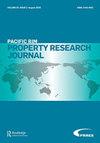The value of a tram station on local house prices: an hedonic modelling approach
IF 0.3
Q3 Economics, Econometrics and Finance
引用次数: 5
Abstract
ABSTRACT There are many drivers of house prices. In urban locations, public infrastructure is considered one of the leading determinants. To explore this relationship, an Hedonic house pricing model was applied to an established Birmingham, the UK working class residential area which is serviced by the Metro Midland tram line. The selected Wednesbury Great Western Street station provides ease of access for the local residents to Birmingham and Wolverhampton City Centres plus there has been recent sale evidence of 100 properties within close proximity to the station. Independent variables consisted of a range of typical physical, locational and neighbourhood attributes for the Hedonic house pricing model input data. Based on the preferred linear Hedonic model, the findings from the recent 100 Wednesbury house sales showed property type, bedrooms, floor area, ambience and distance to the tram station were key explanatory factors in relation to pricing levels. On the evidence provided, property price increased by £16,878 for every km closer to the tram stop. However, when examining properties within defined distance bands with smaller datasets, the location to the tram station was not a significant statistical driver. This suggests that proximity to a public transport access point alongside key housing characteristics should form part of the housing decision making process as they are significant predictors of local house prices.有轨电车车站对当地房价的影响:一种享乐主义的建模方法
推动房价上涨的因素有很多。在城市地区,公共基础设施被认为是主要决定因素之一。为了探索这种关系,我们将Hedonic房屋定价模型应用于伯明翰的一个成熟的英国工人阶级住宅区,该住宅区由地铁米德兰有轨电车线提供服务。选定的韦斯伯里大西街车站为当地居民前往伯明翰和伍尔弗汉普顿市中心提供了便利,而且最近有100处房产在车站附近出售。自变量由一系列典型的物理、位置和邻里属性组成,用于Hedonic房价模型的输入数据。基于首选的线性Hedonic模型,对最近100套韦斯特伯里房屋销售的调查结果显示,房产类型、卧室、建筑面积、环境和到有轨电车站的距离是与价格水平相关的关键解释因素。根据所提供的证据,离电车站每近一公里,房价就会上涨16,878英镑。然而,当使用较小的数据集检查定义距离范围内的属性时,有轨电车车站的位置并不是一个显著的统计驱动因素。这表明,靠近公共交通接入点以及关键住房特征应该成为住房决策过程的一部分,因为它们是当地房价的重要预测因素。
本文章由计算机程序翻译,如有差异,请以英文原文为准。
求助全文
约1分钟内获得全文
求助全文

 求助内容:
求助内容: 应助结果提醒方式:
应助结果提醒方式:


